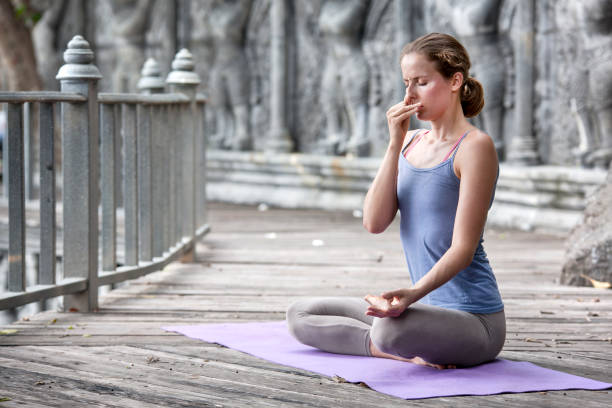In Hatha Yoga, we practice a series of physical exercises intended to purify the subtle energy channels in our body/being so that we may one day experience a state of non-dual unity, that is, an oneness with the divine energy that permeates all things.
Practice begins with physical exercises that are designed to free up energy in our bodies and minds. When our energy system has cleared and awakened, we are ready to begin pranayama.
Literally, the Sanskrit term ” pranayama ” means “extension” or “drawing” out prana. This is a life force. This is a set of breathing exercises that are designed to expand and broaden our awareness so we can continue a subtler purification.
During my years of teaching YEM, Yoga as Energy Medicine, I have observed that many students and teachers have used a specific breathing technique called ujjayi during their practice.
What is Ujjayi breathing?
Ujjayi, or the “victorious breath,” is meant to help in yogic mastery. This is ultimately over the ego and our illusory sense of division.
Even at the beginning stages, some Hatha yoga styles like Ashtanga or Vinyasa encourage the use of ujjayi breath. It’s said to increase concentration, improve endurance, and generate heat in the body to cleanse organs.
Over the years, I have observed and worked with many ujjayi therapists and have noticed a subtle force applied to the body that creates the sound of this breath.
I’ve noticed that people who breathe this way have several common traits: an overheated energy system, minds that tend to be overly alert, muscles that are toned, but energy systems that are either disconnected from the bodies or densely stuck into specific aggregate-like patterns.
In these situations, I discourage the use of ujjayi and instead encourage the subtle application of this simple question: “What’s generating my desire to ujjayi?”
The energy of the ego is tricky and persuasive.
When we grow more attached, we can fool ourselves and others into thinking that we’re evolving spiritually. Hatha Yoga has many shadows. For this reason, any form of pranayama should be practiced with the guidance of an experienced and awakened Yogi Yogiis familiar with the treacherous terrain of the unseen worlds.
To practice ujjayi, a subtle change in airflow is required, creating a sound that sounds like a rushing ocean. Too often, I’ve seen a tendency to use this breath in order to create more tension, both in the practitioner’s physical and energetic systems, instead of burning off the ego-driven sense of self-importance.
Aspiring yoga practitioners may “manufacture” ujjayi. This creates tension, and the energy flow is defeated. I’ve spent a great deal of time in yoga sessions with teachers and students, undoing the blockage that this type of practice creates in both the physical and energetic body.
Any effort requires some willpower.
Where does this willpower originate? Is it a result of our natural connection with nature? Nature arises from our understanding of what yoga is about. What are the goals of applying it?
When we realize that this moment is all we need to fully understand the oneness of everything, any desire to go somewhere else comes from a disconnected place that only perpetuates more of the same. We need to cultivate a witness consciousness when practicing Hatha Yoga of any type. This means that we must be able to witness the effortless movement of the force of life as it flows through our body/being.
Ujjayi, in my opinion, occurs when energy moves effortlessly through a Hatha Yoga practice. Asana, or the physical postures of Hatha yoga, are designed to move energy. Ujjayi is a natural progression of the practice.
We “try” to “get to something out there,” but we are coming from a disconnection. This creates wanting and further disconnection.
Ujjayi is the effortless rising of the breath.
Teachers often describe ujjayi as a constriction at the back of the throat. However, I found that the ujjayi breath is not a tension or constriction but an effortless rising.
The yawn is more like a soft palate opening than a glottal closure. When ujjayi is flowing naturally, the back of the neck and throat are neutral and broad. This allows the breath to be both focused and spacious. The breath flows easily in and out of your nose with a soft, broad palate. Ujjayi’s breath encourages energy to flow spontaneously and naturally from the root center of the yogi Yogio, the crown. The ujjayi breathe a full-body energetic experience that passes through the human. This is the central energy channel that runs along the spine.
The heat from an applied or effortful ujjayi will center around the neck and the base of the head, heating the reptilian centers of the mind and creating more willpower, physical attachment, and ego-driven desire. In my opinion, it defeats the point of the practice.
Why I discourage teaching Ujjayi to students
The Sushumna is not yet a source of fluid energy for most people.
Meditation is often misunderstood as requiring effortless effort.
It can cause energetic disturbances that lead to greater attachments.
When the body/being has reached its readiness, it will naturally arise through practice and instruction.
As one would not “apply” but rather observe a flower blossoming, I also do not “apply” ujjayi. I do not maintain it if it changes spontaneously.
This is the essence of yoga for me. This is the essence of yoga for me.
The best way to do a deeper yoga practice is to encourage yawning to release tension from the jaw, neck, and soft palate. This will allow the ujjayi to emerge naturally. As if opening a bottleneck, I encourage the widening of the throat through various awareness exercises, which help the Sushumna rise and clear.
Focusing on opening and releasing alone leads to a more profound, energetic experience. Mindful breathing, expanding, and releasing can help people become more aware of their bodies. Let’s get into the moment and let Nature NatNatureatha Yoga teach this.
We wish to learn how to practice asana in a witnessing state without imposition of any agenda and allow the natural unfolding process of our body/being. By doing so, we can learn to reveal our incredible interconnection with nature. Nature supports and nurtures unconditionally.




